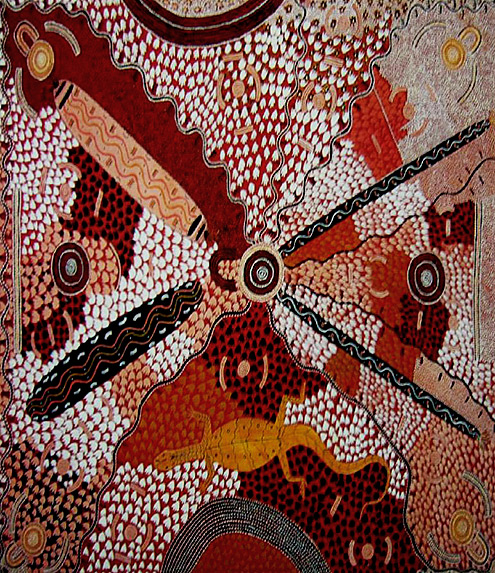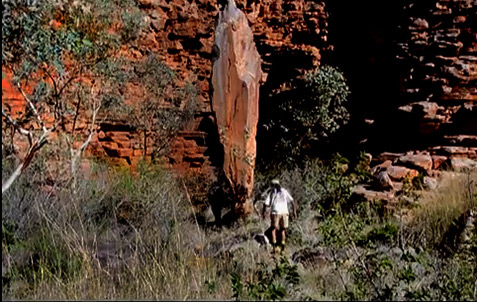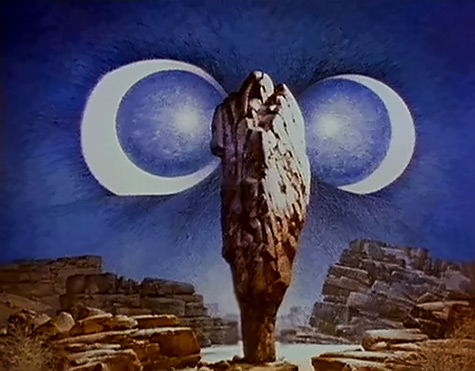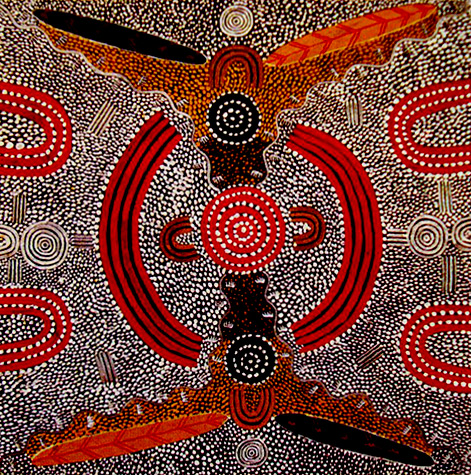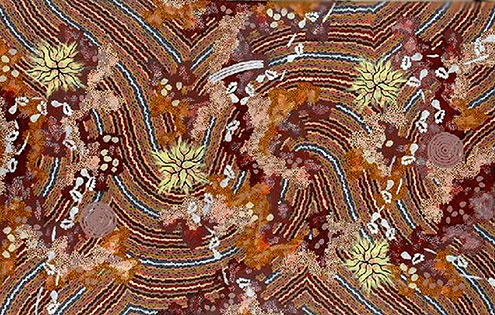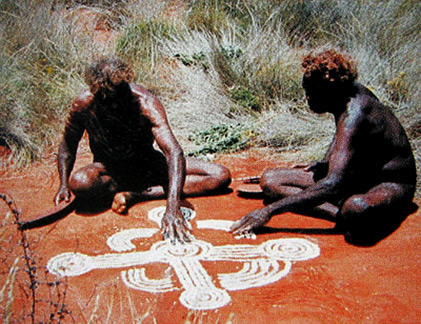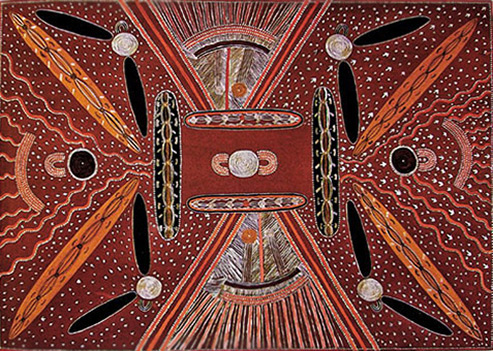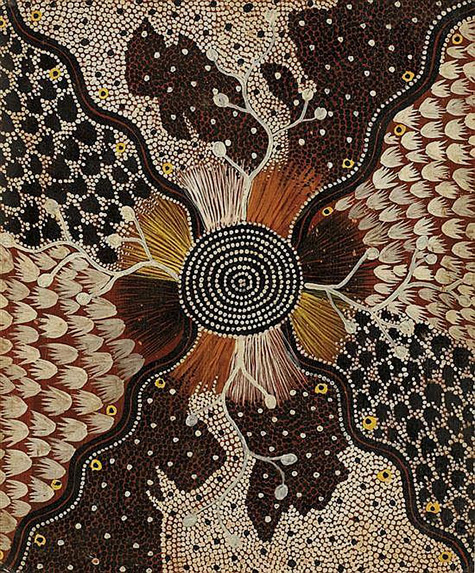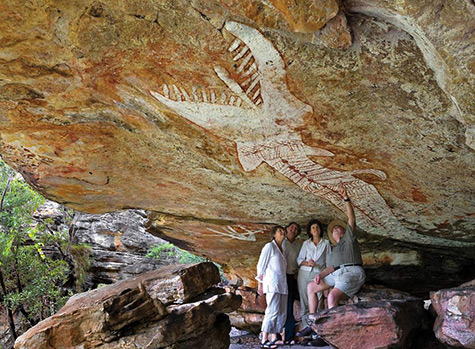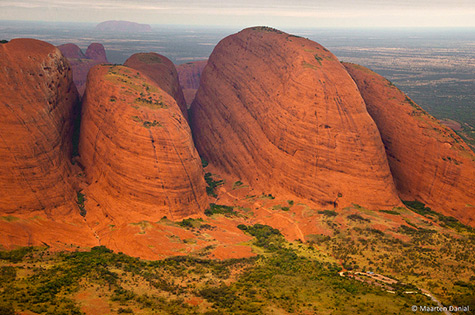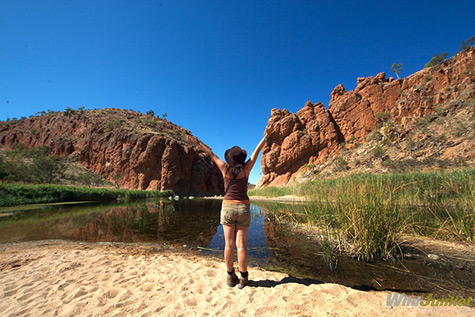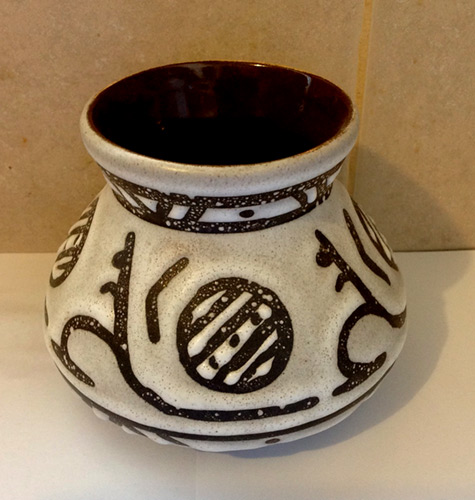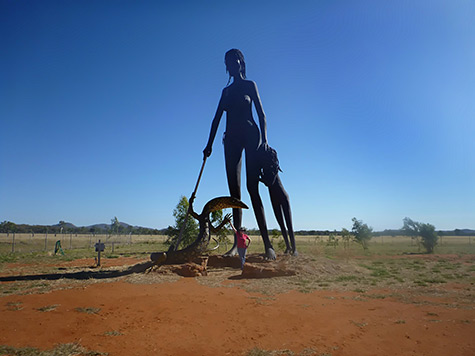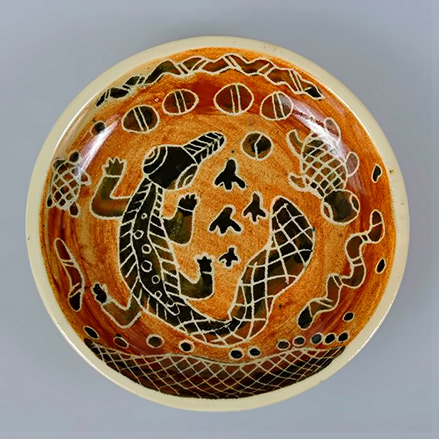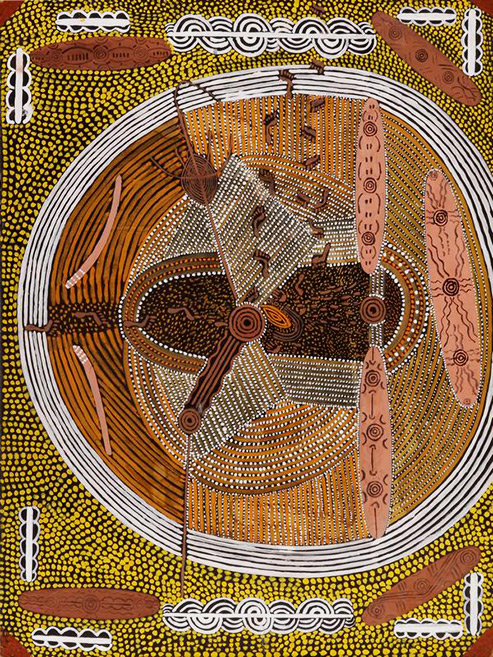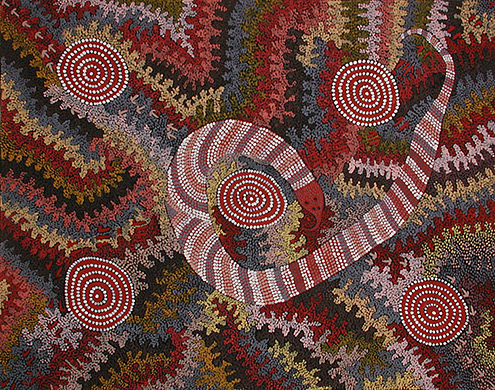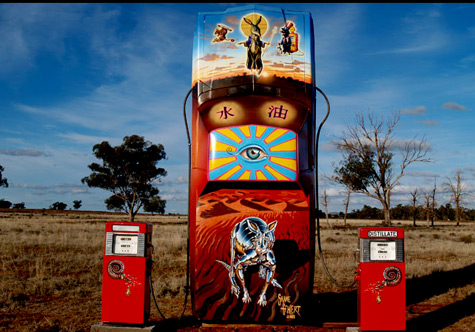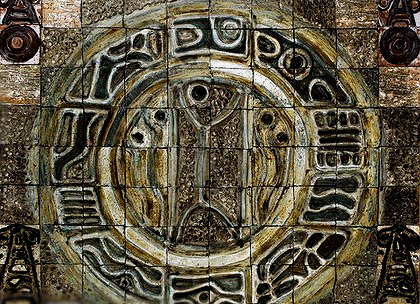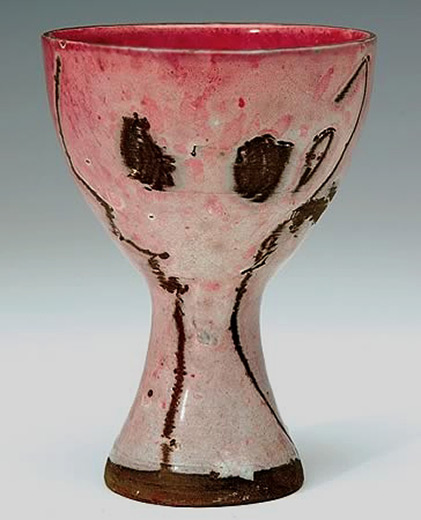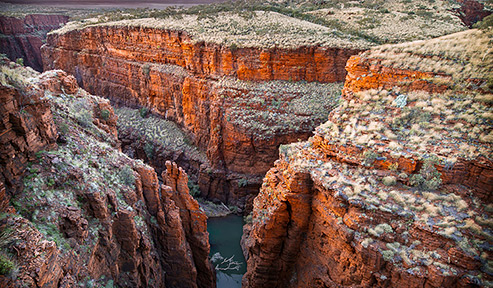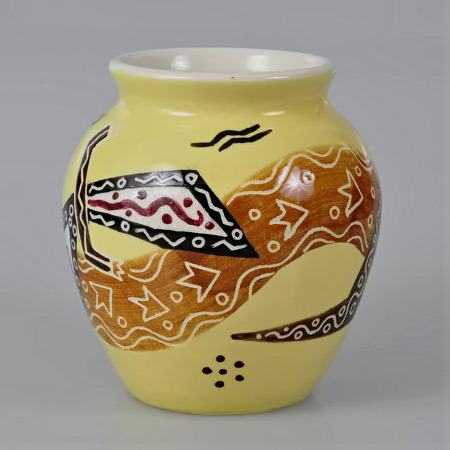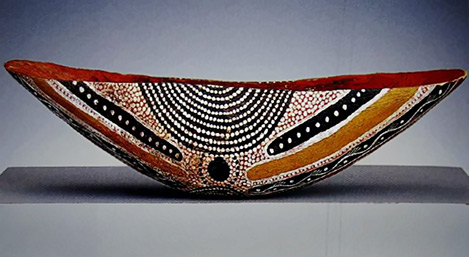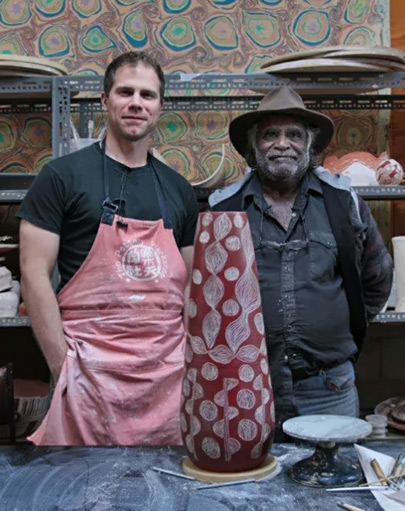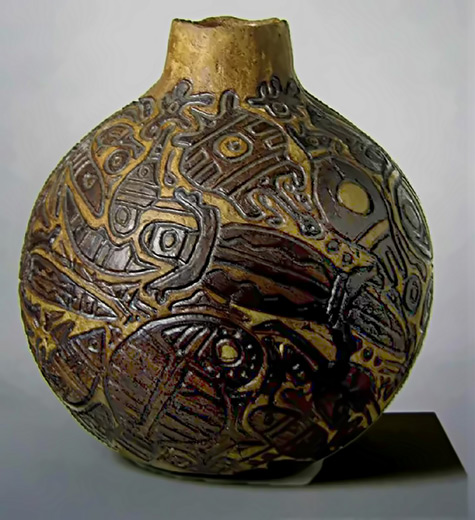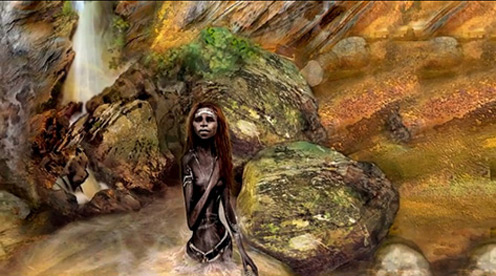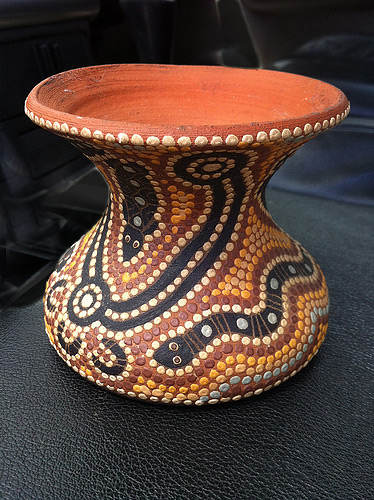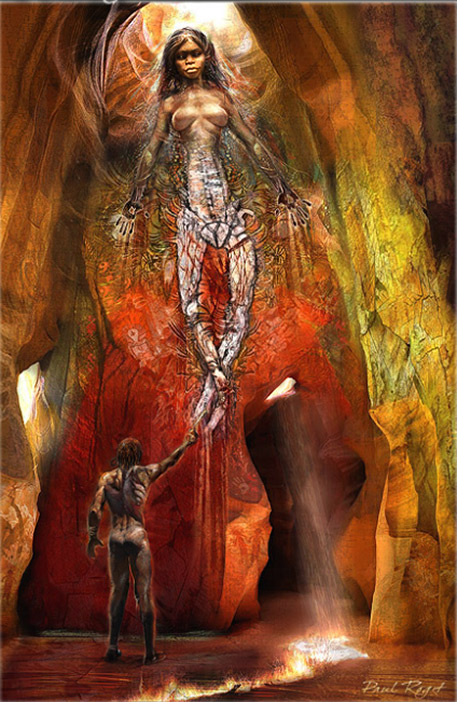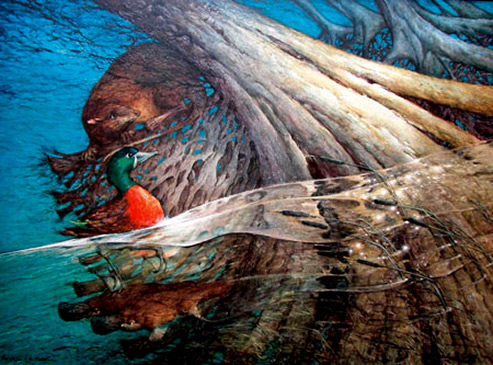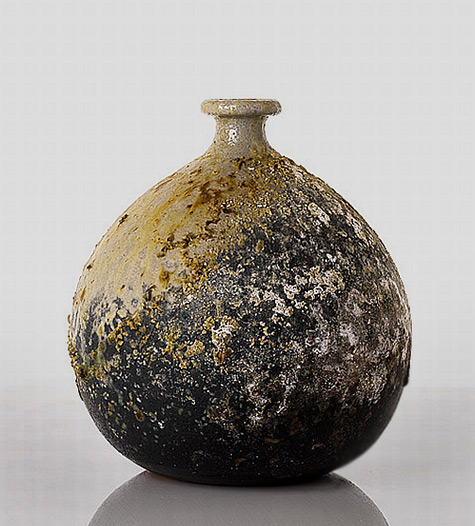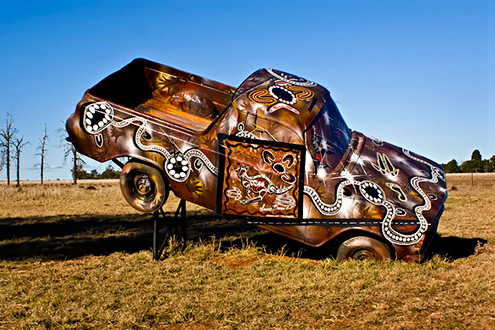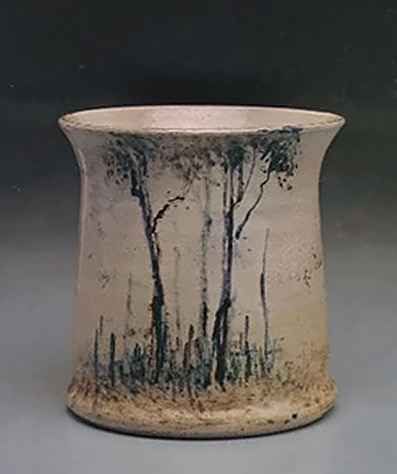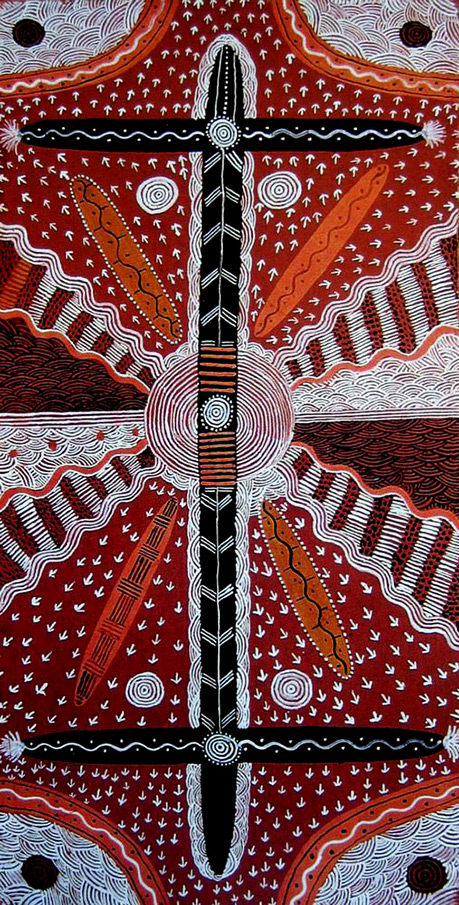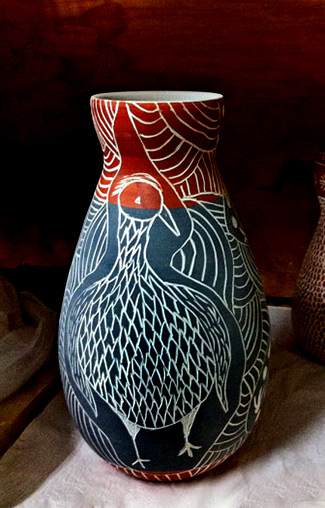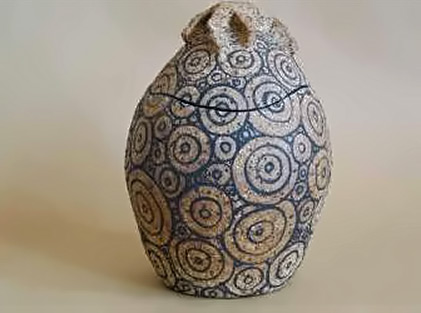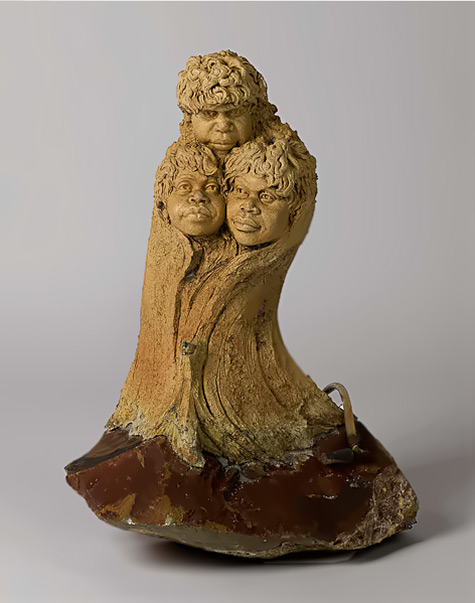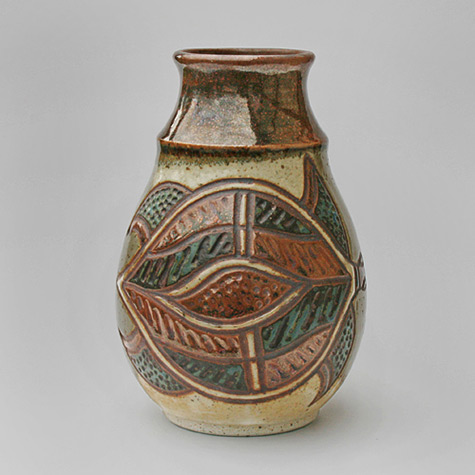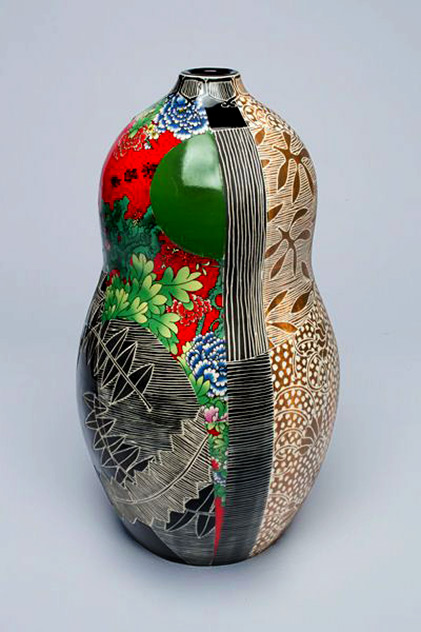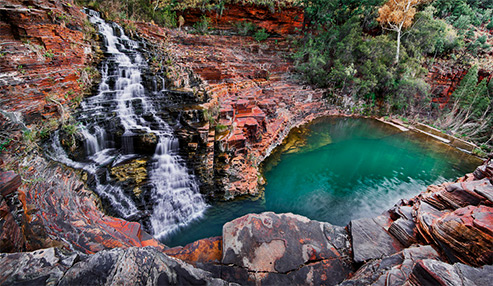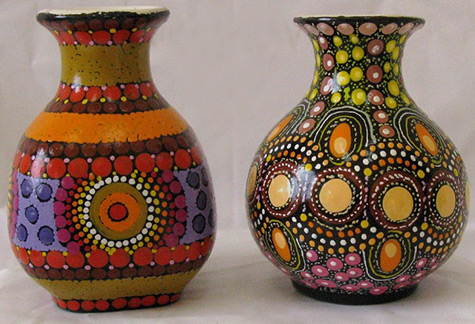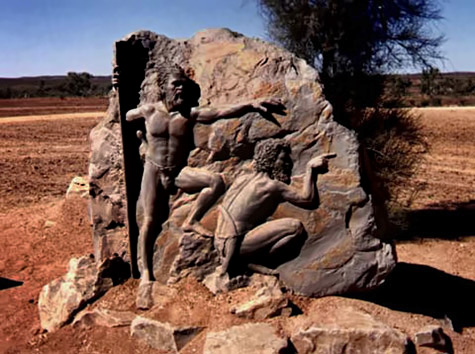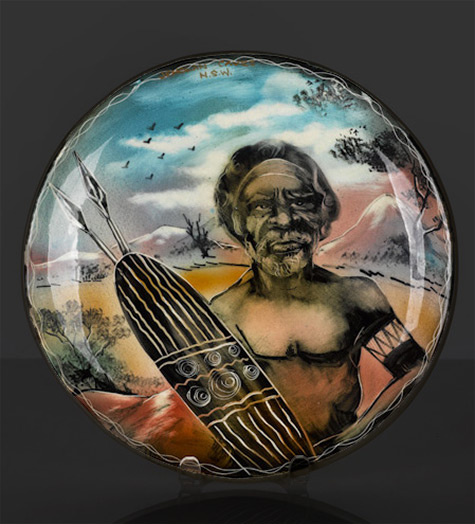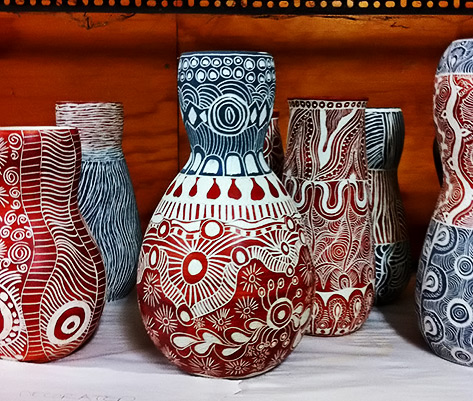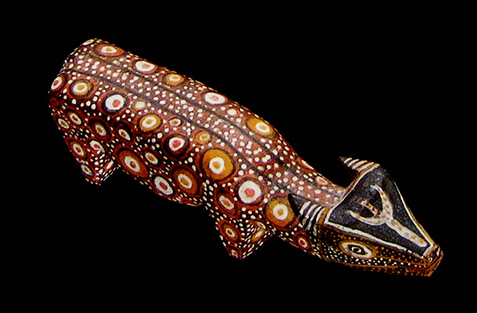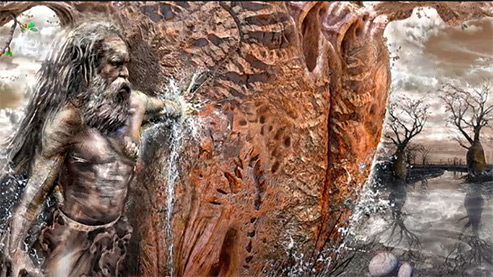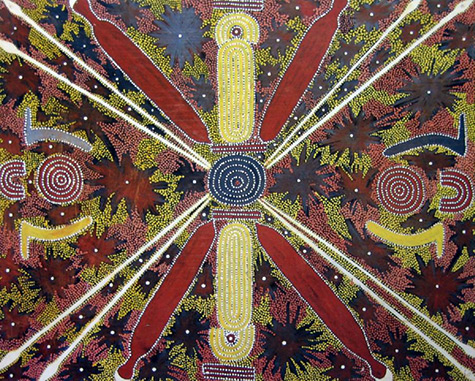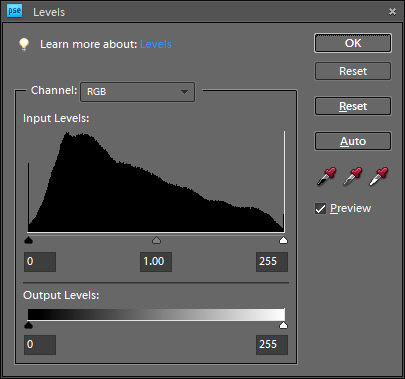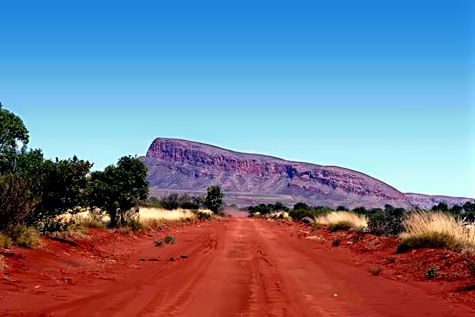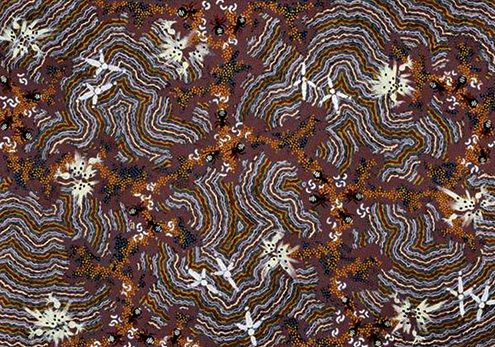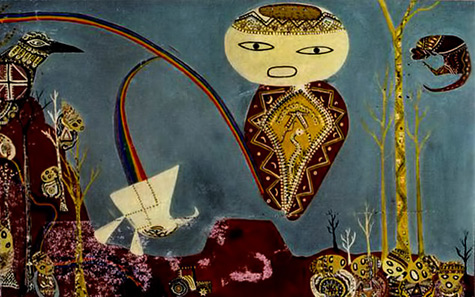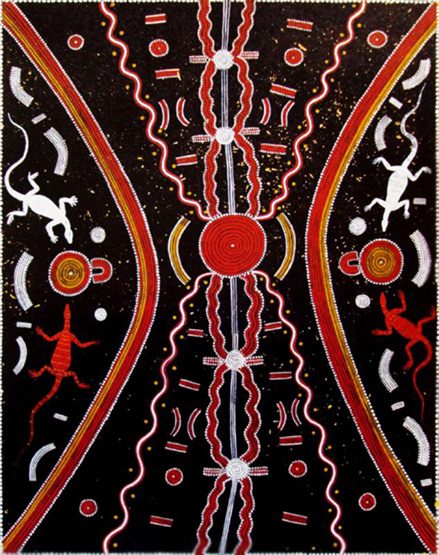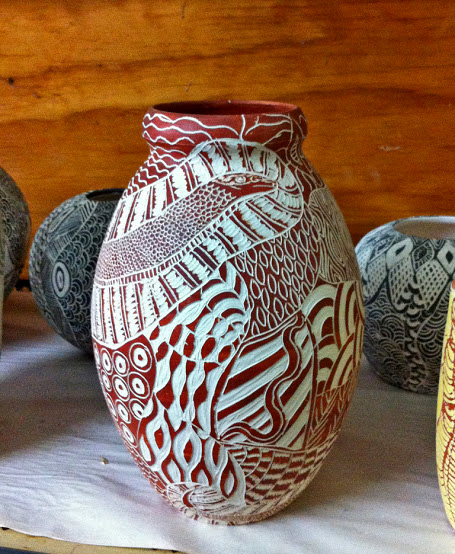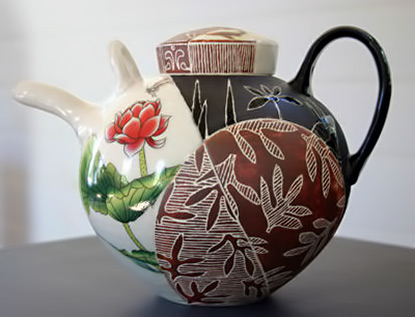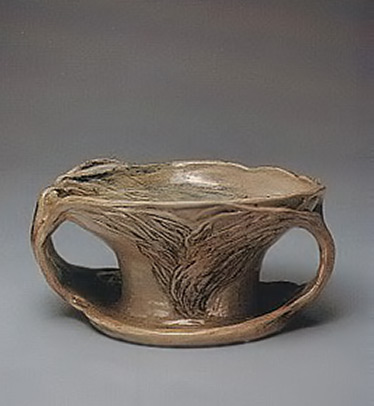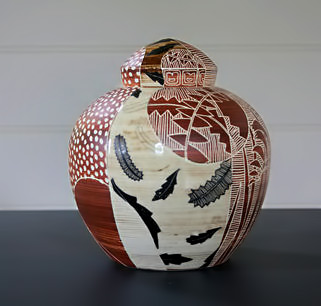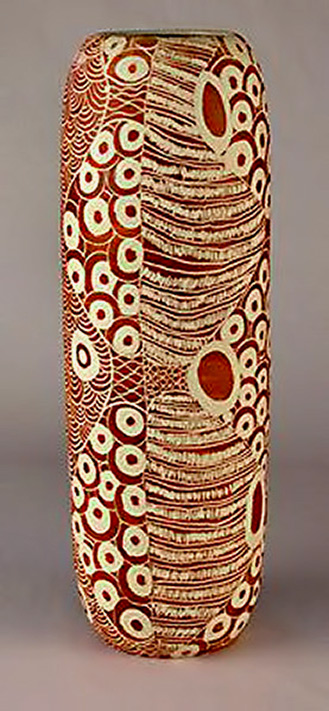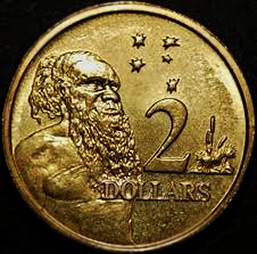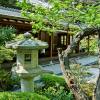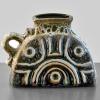Art from the Australian centre.
Outback Art – ‘Goanna at Yuramayi’ – 1973
Kaapa Tjampitjinpa
The Palka Karrinya ( ‘beyond Karrinya’ ) monolith at Central Mount Wedge.
The Palka Karrinya is situated at the entrance to a large gorge which is a sacred site that has been a focal point for ancient Aboriginal ceremony, still practised to this day. Central Mount Wedge is situated in the arid Western Desert of the Northern Territory and is approximately plum centre in the middle of Australia. The white explorer Peter Warburton came here in 1873 and his camels refused to enter the gorge to drink water. The site is only used for female rituals ( ‘womens business’ ) and the woman sing a ‘Bush Plum Dreaming’ song to invoke sustenance for the country and it is communicative in that work is being performed here to keep the site active with everyday life and time.
Circumambulating Palka Karrinya
On entering the Palka Karrinya gorge, it is tradition to circumambulate and touch the monolith stone representing the Jungarrayi ancestor, with a branch of eucalyptus – first timers have to throw a stone in a rock pool nearby. This is why it is worn at the base.
From a Taoist perspective, all the horizontal strata of the rocks in the gorge and the red colour would create a very potent masculine Yang chi. Conversely the sole vertical shard, due to its vertical Yin orientation and the yin water in the rock pool next to it, would concentrate, by virtue of polarity, a powerful Yin feminine force.
Ainslie Roberts – ‘Owl Dreaming’ – Palka Karrinya
Ainslie Roberts visited Palka Karrinya in 1956 on a tour of the sacred sites of Central Australia with Charles Mountford, who had an deep interest in Aboriginal art and culture. Charles was recording the rock art while Ainslie wished to retell the Aboriginal myths in painting, drawing and photography. Of all the sacred places that Ainslie Roberts visited in Central Australia, Palka Karrinya had the most profound influence. He believed that Universal archetypes manifested through myths and could be channelled by the artist. Mountford felt the original spirit of the land could be accessed through the ceremonies, art and myths of the Aborigines and glimpses of ancient powers and histories as old as time itself could be experienced. They used the services of an Aboriginal guide called One Pound Jimmy who currently features on the Aussie $2 coin
Ainslie went on to take up full time painting and the first book of his paintings of traditional indigenous beliefs and practises called ‘The Dreaming’ was published in 1965 and it helped to fill the abyss that existed between the general Australian public and the rich and ancient cultural heritage of Australia.
‘Woman’s Story’ 1973 – Kaapa Tjampitjinpa
Pupunya, NT ( Northern Territory ) – 37.9 km south of Central Mount Wedge
Kaapa is widely credited as a founder, and sometimes the pivotal figure, in the establishment of contemporary Indigenous Australian art. Geoffrey Bardon came to Papunya in the early 1970s and encouraged the Aboriginal people to put their dreaming stories on canvas, which had mainly been previously drawn on the ground or tree bark. Some natural features at particular sites are said to embody a particular dreaming or ancestral figure. The continued presence and influence of the dreamings is acknowledged and the connection between dreamings, people and country is maintained through ceremony and song.
The artists at Pupunya quickly adapted to the use of acrylic paints and a striking new art style emerged which by the 1980s began to attract national and then international attention as a significant art movement.The artistic movement unleashed at Papunya spread over Central Australia and beyond.
‘Napperby Lakes Mount Wedge’ – Clifford Possum Tjapaltjarri
Old Walter Tjampitjinpa & Squeaky Mick Tjakamarra at Pupunya.
Photo; Geoff Bardon
‘Budgerigar Dreaming’ – Aboriginal art – 1972
Kaapa Tjampitjinpa, Pupunya
This painting is composed as a template for ritual, a schematic depiction of the placement of ritual objects and participants in the ceremony.
By painting the designs and stories that represent their particular Dreaming places, Papunya artists assert their rights and obligations as Central and Western Desert landowners, entrusted with the ritual re-enactment of the events that occurred at these sites. The symbols they use are part of a unique visual language which is also used in designs painted on the skin and in elaborate ceremonial ground paintings.
‘Wild Potato’ – Kaapa Tjampitjinpa
Pupunya – 1975
Other images of the land and Aboriginal inspired art.
Mt Borradaile rock art – Arnhem Land
Kata Tjuta ( The Olgas )
Glen Helen Gorge
( wildjunket.com )
Decorative vessel with kangaroo motifs.
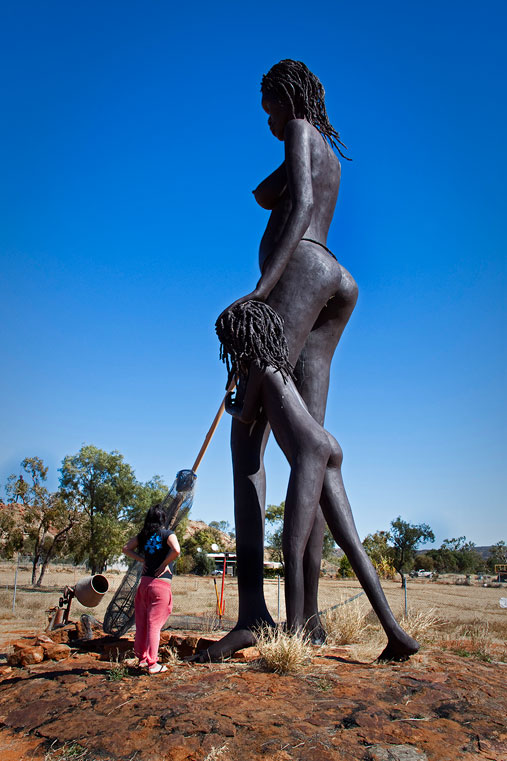
‘Woman, Child and Goanna’ by sculptor Mark Egan
Northern Territory, Australia
‘Woman, Child and Goanna’ by sculptor Mark Egan.
Aileron Roadhouse – Anmatjere Country, NT
Carl Cooper hand painted plate.
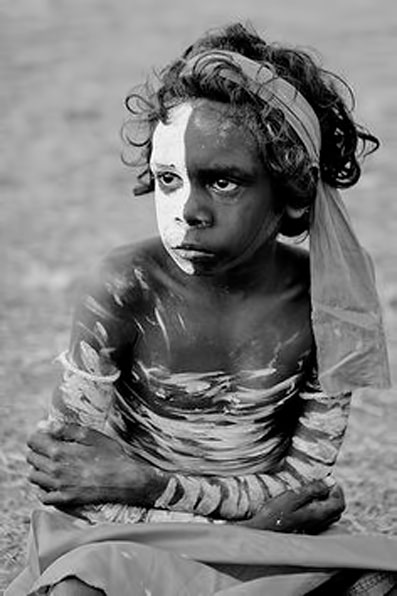
Garma Festival 2007 – Arnhemland Australia
© Cameron Herweynen, via Flickr
‘Love Story’ – Clifford Possum Tjapaltjarri
Son of One Pound Jimmy and first cousin of Kaapa Tjampitjinpa. Clifford was one of the founding fathers of the Pupunya art movement.
Charlie Egalie Tjapaltjarri
Pupunya, NT
‘Epitaph to Fossil Fuels’ by Shane Gehlert
Utes in the paddock – Condobolin
‘Storytelling’ – ceramic tiled mural by Thanakupie
John Perceval -goblet
Karijini National Park
Guy Boyd – Aboriginal Art Vase
Painted Coolamon carved beanwood – Kaapa Tjampitjinpa
1975
Angela Abbott
Wallace Rockhole studio
‘Pot with koala’ – Merric Boyd
Ben and Rupert – Ernabella Arts , NT
( Tales of a Red Clay Rambler – http://carterpottery.blogspot.com.au )
Tharnakupi Ceramic Vessel, QLD
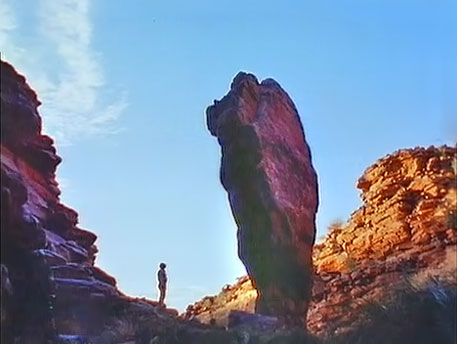
Palka Karrinya sacred monolith
‘Salt of the Earth’ – Paul Roget
Aboriginal dot painting squat waisted vase.
( Flickr Sammik69 )
‘The Birthing’ – Paul Roget
‘The Origin of the Platypus’ – Ainslie Roberts
Col Levy, Bizen style blossom
‘Tribute Ute’ by Lewis Burns
‘Utes in the Paddock’ – Condobolin
Vase Decoration by Doris Boyd 1938
Kaapa Tjampitjinpa
Carlene Turkey Before Firing – Ernabella Arts
( Tales of a Red Clay Rambler – http://carterpottery.blogspot.com.au )
Angela Abbott.
William Ricketts – Large Unglazed Earthenware Sculpture, c. 1978
Yarrabah Pottery
Janet De Boos
Karijini National Park
Photo – Ignacio Palacios
Keringke Aboriginal Art Centre, Santa Teresa, NT
Carl Cooper. Beaker
Matt Johnson sculpture in the Flinders Ranges.
Large ceramic charger – Vande
Womans Sgrafitto Anangu Pottery -Ernabella Arts , NT
( Tales of a Red Clay Rambler – http://carterpottery.blogspot.com.au )
Big Albert Croker – ‘Pig Totem’
Salt Of The Earth – Paul Roget
Kaapa Tjampitjinpa-c.-1975
I was intrigued to notice that quite a few of the Pupunya artworks including the painting above, when viewed in Photoshop, had levels ( balance of light and dark in an image ) that were similar to the appearance of Central Mount Wedge.
Central Mount Wedge, Northern Territory
Australia
Update – 15/11/2014
Archetypal Journey – Karrinyarra Artists
At Mt Wedge, Ada Andy Napaltjarri, hosted us to visit one of her family’s most sacred sites. Pulka Karrinya is a permanent water hole of unusual size tucked in a hidden ravine amongst this range. This group of three mountains are dramatically visible from over 40 miles away, profiled off the endless flat red desert into the wheeling bright blue sky. On entering the numinous sanctuary, Ada was to call out to the ancestors spirits dwelling there, and after guiding us to each break off a branch of gum leaves, she instructed us to approach a tall vertical rock whom she addressed as grandfather, and each in turn walked around this monolith brushing it with our branches. This, we were told, let the grandfather spirit know who was visiting and thus not disturb the sacredness that such a rare resource represented in one of our planets greatest desert wildernesses. Throughout the distant past, when most other water holes dried up over long dry seasons, Ada’s ancestors would have repeatedly retreated to this place, thankful for the life the water represented. Here we heard her songs sung with extraordinary empathy to this land. Often she was to paint this site on her canvases, and speak of the honey ant dreaming associated with this site, and Warumpi, 30 miles south, just outside Papunya; another water hole amongst a flat rocky outcrop. This was her families land, and her father Old Andy Tjungurrayi and her uncle Squeaky Mick Tjakamarra were the ceremonial custodians of these sacred places. We were privileged to witness women’s ceremonies with dance and song for this honey ant dream and were carried out of our encultured perceptions into a memory tone of extraordinary antiquity and identification with the recognition that this outer landscape was also the inner landscape. – from Archetypal Journey – Karrinyarra Artists
‘Honey Ant Dreaming’ – Clifford Possum Tjapaltjarr
1994
‘Contemporary Man and the Rainbow Serpent’ – 1988
Archetypal Journey – Karrinyarra Artists
‘Goanna Dreaming’
Tjampitjinpa, Kaapa Mbitjana Tjampitjinpa,
1973
Aboriginal artist – Derrick WanapiJar incised vase
‘Red Lotus Teapot’ – Janet De Boos
Janet De Boos
Ernabella Ceramics – Derek Thompson
One Pound Jimmy

